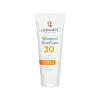What's inside
What's inside
 Key Ingredients
Key Ingredients

 Benefits
Benefits

 Concerns
Concerns

 Ingredients Side-by-side
Ingredients Side-by-side

Water
Skin ConditioningZinc Oxide
Cosmetic ColorantEthylhexyl Stearate
EmollientCaprylic/Capric Triglyceride
MaskingIsostearyl Isostearate
EmollientCetearyl Alcohol
EmollientGlycerin
HumectantPolyglyceryl-3 Methylglucose Distearate
EmulsifyingSucrose Stearate
EmollientCoco-Caprylate
EmollientCocos Nucifera Oil
MaskingCaprylyl Glycol
EmollientIsostearic Acid
CleansingLecithin
EmollientPolyhydroxystearic Acid
EmulsifyingPolyglyceryl-3 Polyricinoleate
EmulsifyingXanthan Gum
EmulsifyingGlyceryl Caprylate
EmollientPropanediol
SolventTocopherol
AntioxidantWater, Zinc Oxide, Ethylhexyl Stearate, Caprylic/Capric Triglyceride, Isostearyl Isostearate, Cetearyl Alcohol, Glycerin, Polyglyceryl-3 Methylglucose Distearate, Sucrose Stearate, Coco-Caprylate, Cocos Nucifera Oil, Caprylyl Glycol, Isostearic Acid, Lecithin, Polyhydroxystearic Acid, Polyglyceryl-3 Polyricinoleate, Xanthan Gum, Glyceryl Caprylate, Propanediol, Tocopherol
Water
Skin ConditioningC12-15 Alkyl Benzoate
AntimicrobialBis-Ethylhexyloxyphenol Methoxyphenyl Triazine
Skin ConditioningMethylpropanediol
SolventDipropylene Glycol Dibenzoate
EmollientMethylene Bis-Benzotriazolyl Tetramethylbutylphenol
UV FilterNiacinamide
SmoothingCyclopentasiloxane
EmollientPotassium Cetyl Phosphate
EmulsifyingPolymethyl Methacrylate
Cetyl Alcohol
EmollientCyclohexasiloxane
EmollientCaffeine
Skin ConditioningHydrogenated Dimer Dilinoleyl/Dimethylcarbonate Copolymer
Emulsion StabilisingLecithin
EmollientTocopheryl Acetate
AntioxidantCamellia Sinensis Leaf Extract
AntimicrobialTocopherol
AntioxidantHelianthus Annuus Seed Oil
EmollientGlycerin
HumectantCaprylyl Glycol
EmollientPPG-15 Stearyl Ether Benzoate
EmollientDecyl Glucoside
CleansingAcrylates/C10-30 Alkyl Acrylate Crosspolymer
Emulsion StabilisingTetrasodium Glutamate Diacetate
Phenylpropanol
MaskingPropylene Glycol
HumectantXanthan Gum
EmulsifyingWater, C12-15 Alkyl Benzoate, Bis-Ethylhexyloxyphenol Methoxyphenyl Triazine, Methylpropanediol, Dipropylene Glycol Dibenzoate, Methylene Bis-Benzotriazolyl Tetramethylbutylphenol, Niacinamide, Cyclopentasiloxane, Potassium Cetyl Phosphate, Polymethyl Methacrylate, Cetyl Alcohol, Cyclohexasiloxane, Caffeine, Hydrogenated Dimer Dilinoleyl/Dimethylcarbonate Copolymer, Lecithin, Tocopheryl Acetate, Camellia Sinensis Leaf Extract, Tocopherol, Helianthus Annuus Seed Oil, Glycerin, Caprylyl Glycol, PPG-15 Stearyl Ether Benzoate, Decyl Glucoside, Acrylates/C10-30 Alkyl Acrylate Crosspolymer, Tetrasodium Glutamate Diacetate, Phenylpropanol, Propylene Glycol, Xanthan Gum
 Reviews
Reviews

Ingredients Explained
These ingredients are found in both products.
Ingredients higher up in an ingredient list are typically present in a larger amount.
Caprylyl Glycol is a humectant and emollient, meaning it attracts and preserves moisture.
It is a common ingredient in many products, especially those designed to hydrate skin. The primary benefits are retaining moisture, skin softening, and promoting a healthy skin barrier.
Though Caprylyl Glycol is an alcohol derived from fatty acids, it is not the kind that can dry out skin.
This ingredient is also used as a preservative to extend the life of products. It has slight antimicrobial properties.
Learn more about Caprylyl GlycolGlycerin is already naturally found in your skin. It helps moisturize and protect your skin.
A study from 2016 found glycerin to be more effective as a humectant than AHAs and hyaluronic acid.
As a humectant, it helps the skin stay hydrated by pulling moisture to your skin. The low molecular weight of glycerin allows it to pull moisture into the deeper layers of your skin.
Hydrated skin improves your skin barrier; Your skin barrier helps protect against irritants and bacteria.
Glycerin has also been found to have antimicrobial and antiviral properties. Due to these properties, glycerin is often used in wound and burn treatments.
In cosmetics, glycerin is usually derived from plants such as soybean or palm. However, it can also be sourced from animals, such as tallow or animal fat.
This ingredient is organic, colorless, odorless, and non-toxic.
Glycerin is the name for this ingredient in American English. British English uses Glycerol/Glycerine.
Learn more about GlycerinLecithin is a term for a group of substances found in the cell membranes of plants, animals, and humans. They are made up of mixture of phospholipids.
This ingredient has emollient and emulsifying properties.
As an emollient, lecithen helps soften the skin and creates a barrier to keep moisture in.
As an emulsifier, it also helps prevent water and oil ingredients from separating. Lecithin can also help ingredients be better absorbed by the skin.
This is because the phospholipids in lecithin produce liposomes. Liposomes help other ingredients get through the skin barrier.
Depending on the source of this ingredient, lecithin may not be fungal acne safe. This is because some sources of lecithin come from soybean oil, which may feed the malassezia yeast that feeds fungal acne.
We recommend reaching out to the brand you are purchasing from to inquire about the source of their lecithin.
Some other names for this ingredient include soy lecithin and deoiled soy lecithin.
Learn more about LecithinTocopherol (also known as Vitamin E) is a common antioxidant used to help protect the skin from free-radicals and strengthen the skin barrier. It's also fat soluble - this means our skin is great at absorbing it.
Vitamin E also helps keep your natural skin lipids healthy. Your lipid skin barrier naturally consists of lipids, ceramides, and fatty acids. Vitamin E offers extra protection for your skin’s lipid barrier, keeping your skin healthy and nourished.
Another benefit is a bit of UV protection. Vitamin E helps reduce the damage caused by UVB rays. (It should not replace your sunscreen). Combining it with Vitamin C can decrease sunburned cells and hyperpigmentation after UV exposure.
You might have noticed Vitamin E + C often paired together. This is because it is great at stabilizing Vitamin C. Using the two together helps increase the effectiveness of both ingredients.
There are often claims that Vitamin E can reduce/prevent scarring, but these claims haven't been confirmed by scientific research.
Learn more about TocopherolWater. It's the most common cosmetic ingredient of all. You'll usually see it at the top of ingredient lists, meaning that it makes up the largest part of the product.
So why is it so popular? Water most often acts as a solvent - this means that it helps dissolve other ingredients into the formulation.
You'll also recognize water as that liquid we all need to stay alive. If you see this, drink a glass of water. Stay hydrated!
Learn more about WaterXanthan gum is used as a stabilizer and thickener within cosmetic products. It helps give products a sticky, thick feeling - preventing them from being too runny.
On the technical side of things, xanthan gum is a polysaccharide - a combination consisting of multiple sugar molecules bonded together.
Xanthan gum is a pretty common and great ingredient. It is a natural, non-toxic, non-irritating ingredient that is also commonly used in food products.
Learn more about Xanthan Gum